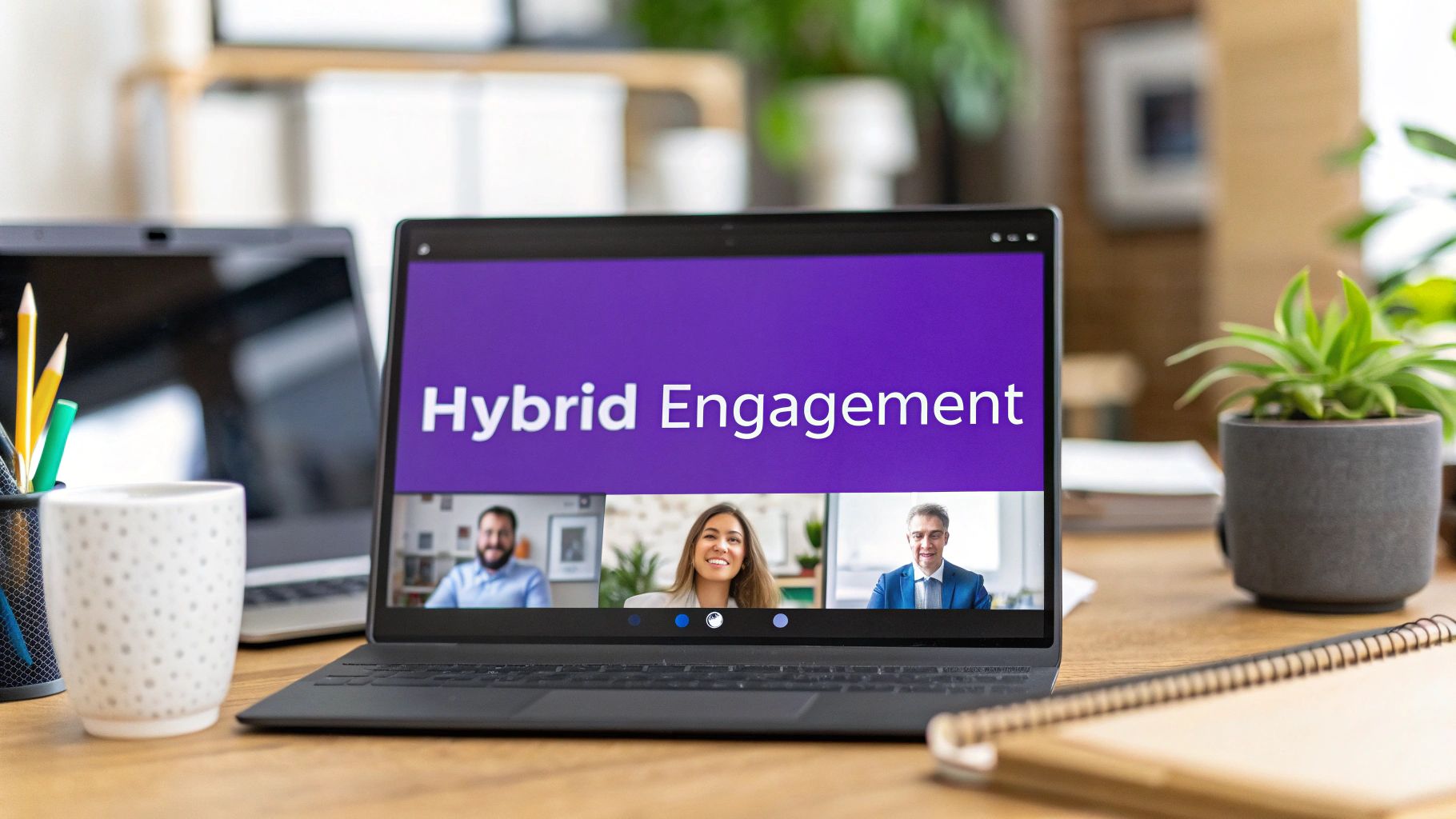In a world of flexible work, keeping your team connected and motivated is more critical than ever. The old methods don't always translate to remote or hybrid setups, often leading to disconnection and burnout. When team members are spread across different locations and time zones, fostering a strong sense of community and purpose requires a deliberate, fresh approach. Generic advice falls flat; teams need practical, specific strategies that address the real challenges of distributed work.
This guide moves beyond the basics, offering fresh, actionable employee engagement ideas specifically designed for modern teams. We will explore 10 powerful strategies that build a resilient, engaged, and productive culture, no matter where your team members log in from. You won't find vague tips here. Instead, you'll get a playbook filled with concrete steps to improve everything from recognition and professional development to wellness and inclusion.
Each idea is broken down into a simple, actionable format to help you implement it immediately. Get ready to transform your approach to team engagement and create a workplace where every individual feels valued, connected, and inspired to do their best work.
1. Build a Culture of Continuous Recognition
Annual performance reviews are no longer enough to keep employees motivated, especially in remote and hybrid settings where great work can easily become invisible. A culture of continuous recognition celebrates achievements as they happen, creating a constant feedback loop that reinforces positive behaviors and keeps engagement high. This approach shifts recognition from a once-a-year event to a daily habit woven into your company's fabric.

This method moves beyond generic praise by focusing on specific, timely, and value-aligned acknowledgments. By empowering everyone, from managers to peers, to give kudos, you build a powerful network of appreciation. This is one of the most effective employee engagement ideas because it directly connects an individual’s contributions to team and company success, fostering a strong sense of purpose and belonging.
How to Implement Continuous Recognition
- Launch a Peer-to-Peer "Shout-Out" Channel: Use a dedicated Slack or Teams channel where anyone can publicly thank a colleague for their help or a job well done. Encourage specificity by asking posters to mention the specific action and the company value it demonstrated.
- Integrate Recognition into Meetings: Start team meetings with a "wins of the week" segment where managers and peers can share recent successes. This makes recognition a consistent and visible part of your team's routine.
- Use a Recognition Platform: Tools like Bonusly or Kazoo allow employees to give each other small, meaningful bonuses or points that can be redeemed for rewards. This gamifies the process and makes recognition tangible.
- Combine Digital and Physical Rewards: While digital shout-outs are great, tangible acknowledgments can make a lasting impact. When building out your recognition program, consider incorporating personalized promotional products to make acknowledgments more memorable and show individual appreciation. A custom-branded mug or high-quality notebook celebrating a major milestone feels far more special than just an email.
2. Professional Development and Learning Opportunities
Investing in your employees' growth is a direct investment in your company's future. Professional development opportunities show team members they are valued assets, not just cogs in a machine. This commitment to their career advancement builds loyalty and equips them with new skills that drive innovation and organizational success, making it a powerful tool in your arsenal of employee engagement ideas.
This approach goes beyond simply offering a training budget. It involves creating clear pathways for growth, aligning learning with career goals, and fostering a culture where knowledge is actively shared. By providing resources like certifications, workshops, and mentorship, you empower employees to take control of their careers, which boosts both their confidence and their contribution to the team.
How to Implement Professional Development
- Create Personalized Growth Plans: Work with each employee to identify their career aspirations and map out a learning path. Align these plans with company goals to create a win-win scenario where individual growth directly supports business objectives.
- Offer Diverse Learning Formats: Cater to different learning styles by providing a mix of resources. This could include subscriptions to online platforms like Coursera or LinkedIn Learning, sponsoring industry conference attendance, or creating internal mentorship programs.
- Encourage Knowledge Sharing: Ask employees to present what they've learned to their teams after completing a course or workshop. This reinforces their learning, spreads new knowledge across the organization, and positions them as subject matter experts.
- Make Learning Engaging: Traditional training can sometimes feel like a chore. For innovative approaches to skill enhancement that keep learning exciting, consider exploring the benefits of gamified professional development.
3. Flexible Work Arrangements and Remote Work Options
The traditional 9-to-5 office model is no longer the only path to productivity. Offering flexible work arrangements, such as remote options, flexible hours, or compressed workweeks, empowers employees to integrate their work and personal lives more effectively. This autonomy is a powerful driver of engagement, as it demonstrates trust and respect for employees as individuals with unique needs and circumstances.
This approach is about giving employees control over how, when, and where they do their best work. For companies like GitLab and Atlassian, this isn't just a perk; it's a core part of their operational strategy. Implementing these options makes your company a more attractive place to work and is one of the most impactful employee engagement ideas for retaining top talent who value work-life balance and a modern approach to productivity.
How to Implement Flexible Work Arrangements
- Establish Clear Policies and Expectations: Create a formal remote work policy that outlines communication norms, core working hours (if any), and performance expectations. Clarity prevents confusion and ensures everyone is aligned, regardless of their location.
- Invest in the Right Collaboration Tools: Equip your team with the necessary technology to succeed. This includes project management software like Asana, communication platforms like Slack, and video conferencing tools like Zoom to keep everyone connected and productive.
- Promote an Asynchronous Mindset: Encourage a work culture where immediate responses aren't always expected. To learn more about this, you can explore the benefits of an asynchronous work schedule. This reduces pressure and accommodates different time zones and personal schedules.
- Ensure Equal Opportunities: Actively work to prevent proximity bias by ensuring that remote employees have the same opportunities for promotions, challenging projects, and visibility as their in-office counterparts. Make career development discussions a standard part of manager one-on-ones.
4. Health and Wellness Programs
Prioritizing employee well-being is a powerful strategy for boosting engagement, as burnout and stress are significant barriers to productivity and morale. Health and wellness programs demonstrate that a company cares for its team as people, not just as workers. This holistic approach supports physical, mental, and emotional health, creating a resilient and motivated workforce that feels valued and supported.

These initiatives move beyond basic health insurance by offering proactive resources that help employees thrive. For remote and hybrid teams, accessible wellness programs are crucial for combating isolation and maintaining a healthy work-life balance. By investing in well-being, you are implementing one of the most impactful employee engagement ideas, leading to reduced absenteeism, higher retention, and a more positive company culture where everyone can perform at their best.
How to Implement Health and Wellness Programs
- Offer Diverse and Flexible Options: Provide a menu of wellness benefits that cater to different needs, such as a stipend for gym memberships, subscriptions to mindfulness apps like Calm or Headspace, or access to virtual fitness classes.
- Prioritize Mental Health Support: Make mental health a key focus by offering confidential access to counseling services through an Employee Assistance Program (EAP). Normalize conversations around mental well-being by hosting workshops on stress management and burnout prevention.
- Encourage Movement and Breaks: Promote physical activity during the workday. Launch a team-wide steps challenge, offer subsidies for ergonomic home office setups, or schedule "walking meetings" to encourage employees to get away from their desks.
- Provide Access to Health Experts: Partner with nutritionists, financial advisors, and mental health professionals to host webinars and Q&A sessions. These events provide valuable, expert-led guidance that empowers employees to take control of their well-being.
5. Team Building and Social Connection Activities
In remote and hybrid environments, the spontaneous "water cooler" conversations that build relationships have disappeared. Structured and informal social activities are essential for intentionally building camaraderie, strengthening communication, and fostering a sense of community. These initiatives create shared experiences that help team members connect on a personal level, which directly boosts collaboration and engagement.

This approach goes beyond just "forced fun" by focusing on creating genuine connections that make work more enjoyable and teams more cohesive. By offering a mix of activities, you cater to diverse interests and personalities, ensuring everyone feels included. When implemented thoughtfully, these employee engagement ideas help break down silos and build the psychological safety needed for high-performing teams, making work feel less transactional and more like a community.
How to Implement Team Building and Social Connection
- Schedule Regular, Low-Pressure Virtual Events: Host monthly virtual coffee chats, online game sessions (like Jackbox Games), or a "lunch and learn" where a team member shares a personal hobby. The key is consistency and keeping it optional.
- Support Employee-Led Interest Groups: Create channels for shared interests like #book-club, #gamers, or #fitness-fans. Empower employees to organize their own meetups, whether virtual or in-person, fostering organic connections.
- Organize In-Person Offsites or Meetups: For hybrid or remote-first companies, bringing the team together once or twice a year for a dedicated offsite can be incredibly powerful. Focus on a mix of strategic planning and pure social time.
- Launch a Volunteer Program: Partner with a charity for a company-wide volunteer day or offer paid time off for individual volunteering. Working together for a common cause is a powerful way to build bonds and connect with company values. To find more inspiration, explore these group activities to build teamwork.
6. Clear Communication and Transparency Initiatives
In remote and hybrid work environments, ambiguity is the enemy of engagement. When employees lack clarity about company direction, performance, or changes, they can feel disconnected and anxious. Clear communication and transparency initiatives build a foundation of trust by keeping everyone informed, involved, and aligned, making them feel like valued stakeholders rather than just employees.
This approach involves openly sharing both successes and challenges, from financial performance to strategic pivots. Inspired by frameworks like Kim Scott's "Radical Candor" and the open-book management model, it fosters a culture where honest conversations are the norm. This is one of the most critical employee engagement ideas for distributed teams, as it bridges the physical distance with psychological safety and a shared sense of purpose.
How to Implement Clear Communication and Transparency
- Host Regular "Ask Me Anything" (AMA) Sessions: Schedule monthly or quarterly all-hands meetings where leadership answers unfiltered questions from employees. This demonstrates a commitment to openness and directly addresses concerns.
- Create a "Single Source of Truth": Use a centralized hub like a company intranet or Notion page to document important decisions, strategic plans, and team goals. Ensure it's kept up-to-date so everyone has access to the same information.
- Share Both Wins and Losses: When discussing company performance, don’t just highlight the successes. Be transparent about challenges and what is being done to address them. This builds credibility and resilience within the team.
- Document and Distribute Key Decisions: After important meetings, share a summary of the decisions made and the reasoning behind them. For more strategies, you can learn more about how to improve team communication to ensure everyone stays aligned, regardless of their location.
7. Purpose-Driven Work and Mission Alignment
Employees today seek more than just a paycheck; they want to contribute to something meaningful. Purpose-driven work creates a clear, tangible link between an individual's daily tasks and the organization's overarching mission. When team members see how their efforts contribute to a larger, positive impact, their motivation and loyalty deepen, transforming their job into a vocation.
This approach goes beyond a mission statement on a website. It involves embedding your company’s purpose into every aspect of the employee experience, from onboarding to project kickoffs. Highlighting this connection is one of the most powerful employee engagement ideas because it taps into the intrinsic human need for meaning, making work feel significant and inspiring, especially for remote teams who can feel disconnected from the bigger picture.
How to Implement Purpose-Driven Work
- Connect Daily Tasks to the Mission: During team meetings and one-on-ones, managers should explicitly explain how specific projects and tasks help achieve the company's mission. For example, a software developer isn't just fixing bugs; they're improving a product that helps non-profits manage their donations more effectively.
- Share Impact Stories: Regularly share stories and testimonials from customers or the community that highlight the real-world impact of your team's work. Use a dedicated Slack channel or a segment in company-wide meetings to showcase these powerful narratives.
- Integrate Purpose into Goals: Frame individual and team goals (like OKRs) in the context of the company mission. This ensures everyone understands how their performance directly contributes to the organization's purpose.
- Empower Employees to Be Ambassadors: Give employees paid time off to volunteer for causes aligned with your mission. This not only reinforces your company's values but also allows employees to experience the purpose firsthand, strengthening their connection to the organization's goals.
8. Autonomy and Empowerment in Decision-Making
Micromanagement is a powerful demotivator, especially for remote and hybrid teams where trust is paramount. Empowering employees with autonomy means giving them meaningful authority and control over their work. This approach moves beyond simply delegating tasks to trusting your team with the freedom to make decisions, contribute ideas, and own their outcomes.
This strategy is one of the most impactful employee engagement ideas because it taps into intrinsic motivation. When employees feel trusted and responsible, their investment in their work deepens, leading to greater innovation, accountability, and job satisfaction. Inspired by models like Netflix's 'Freedom and Responsibility' culture, it builds a team of proactive problem-solvers rather than passive instruction-followers.
How to Implement Autonomy and Empowerment
- Set Clear Goals, Not Rigid Processes: Define the desired outcome or "what" needs to be achieved, but give your team the flexibility to determine the "how." This allows for creativity and ownership while ensuring alignment with company objectives.
- Establish "Guardrails, Not Cages": Provide clear boundaries, budgets, and non-negotiables to guide decision-making. This creates a safe space for experimentation without risking critical errors, ensuring employees feel secure enough to take initiative.
- Rotate Project Leadership: Offer opportunities for different team members to lead projects or initiatives. This distributes responsibility, builds new skills across the team, and demonstrates trust in everyone's capabilities.
- Create Psychological Safety: Foster an environment where intelligent failures are treated as learning opportunities, not punishable offenses. When employees aren't afraid to experiment, they are more likely to innovate and make bold decisions.
9. One-on-One Meetings and Personalized Development Plans
Generic, team-wide initiatives often miss the mark because engagement is deeply personal. One-on-one meetings, when done correctly, shift the focus from broad-stroke management to individual coaching and support. These dedicated sessions provide a safe, confidential space for employees to discuss challenges, celebrate wins, and map out their future, making them feel seen and valued as individuals rather than just cogs in a machine.
This approach transforms the manager-employee relationship from a simple reporting structure into a genuine partnership focused on growth. By regularly dedicating time to an individual’s career path and well-being, managers demonstrate a powerful commitment to their team members' success. This is one of the most impactful employee engagement ideas because it directly addresses personal and professional needs, building trust and loyalty that company-wide perks simply can't replicate.
How to Implement Effective One-on-Ones
- Establish a Consistent Cadence: Schedule recurring one-on-one meetings weekly or bi-weekly. Consistency is key to building trust and making these conversations a natural part of the work routine, not a rare, high-pressure event.
- Create a Shared Agenda: Use a shared document where both the manager and the employee can add topics for discussion. This empowers the employee to drive the conversation and ensures their most pressing concerns are addressed.
- Focus on Coaching, Not Just Status Updates: Go beyond project updates. Use coaching questions like, "What part of your work is most energizing right now?" or "What skills do you want to develop in the next quarter?" to guide conversations toward growth and development. For a deeper dive into structuring these conversations, explore these strategies for effective one-on-one meetings.
- Document and Follow Through on Development Goals: Work together to create a simple, actionable development plan. Document the goals and action items discussed, and make sure to follow up on progress in subsequent meetings. This shows commitment and ensures accountability.
10. Diversity, Equity, Inclusion, and Belonging (DEIB) Initiatives
A genuine commitment to Diversity, Equity, Inclusion, and Belonging (DEIB) is foundational to modern employee engagement. It involves creating a workplace where all employees feel valued, respected, and empowered to bring their full, authentic selves to work. These initiatives move beyond compliance to actively address systemic barriers and foster an environment where everyone has an equal opportunity to thrive and contribute.
This approach is one of the most powerful employee engagement ideas because it directly impacts psychological safety and belonging, two core human needs. When employees see their identities and perspectives reflected and respected, they are more likely to be innovative, collaborative, and committed. Companies like Salesforce, which invested over $16 million to close pay gaps, show that DEIB is a strategic business imperative, not just an HR function.
How to Implement DEIB Initiatives
- Establish and Support Employee Resource Groups (ERGs): Provide official support, funding, and an executive sponsor for ERGs. These groups offer safe spaces for employees with shared identities and are invaluable sources of feedback for the organization.
- Integrate DEIB into Leadership Goals: Make DEIB metrics a part of executive and managerial performance reviews. Tie compensation and bonuses to tangible progress in diversity, representation, and inclusion scores to ensure accountability.
- Conduct Regular Inclusivity and Equity Audits: Go beyond diversity metrics by regularly surveying employees on their sense of belonging and psychological safety. Use this data to identify and address specific pain points within different teams or demographics.
- Promote Education on Unconscious Bias: Implement ongoing training to help all team members recognize and mitigate biases. Understanding unconscious bias in creative ideas is a critical step toward building a truly inclusive culture where all voices are heard.
10 Employee Engagement Ideas — Comparison
| Program | 🔄 Implementation Complexity | ⚡ Resource Requirements | 📊 Expected Outcomes | 💡 Ideal Use Cases | ⭐ Key Advantages |
|---|---|---|---|---|---|
| Employee Recognition and Rewards Programs | Low–Medium; repeatable workflows and admin | Low–Medium budget; platform or token rewards | Higher morale, retention, productivity | Quick morale boost; celebrating milestones; company-wide | High impact per cost; scalable |
| Professional Development and Learning Opportunities | Medium–High; curriculum, partnerships, tracking | High—training budgets, time, vendor costs | Improved skills, retention, internal mobility | Skill gaps, succession planning, growth-oriented orgs | Builds long-term capability; attracts talent |
| Flexible Work Arrangements and Remote Work Options | Medium; policy, management and security setup | Medium—collaboration tools, security; may reduce office costs | Better work-life balance, retention, wider talent pool | Knowledge work, distributed teams, recruiting geographically | Increases satisfaction; cost-saving potential |
| Health and Wellness Programs | Medium–High; vendor coordination and privacy management | High—programs, facilities, vendor fees | Reduced absenteeism, improved wellbeing and energy | High-stress roles, large orgs, wellbeing focus | Long-term health cost reduction; improves morale |
| Team Building and Social Connection Activities | Low–Medium; event planning and facilitation | Low–Medium—events budget and time | Stronger collaboration, belonging, trust | New teams, onboarding, culture reinforcement | Strengthens relationships; improves teamwork |
| Clear Communication and Transparency Initiatives | Medium; leadership cadence and information design | Low–Medium—platforms, leader time | Increased trust, alignment, reduced rumors | Change management, distributed teams, strategic alignment | Builds trust; aligns workforce to goals |
| Purpose-Driven Work and Mission Alignment | Medium–High; cultural embedding and storytelling | Low–Medium—communications, programs, measurement | Higher intrinsic motivation, loyalty, retention | Mission-driven orgs; talent attraction and retention | Drives intrinsic motivation; deepens engagement |
| Autonomy and Empowerment in Decision-Making | High; governance, training, guardrails required | Medium—training, governance tools, time | Faster innovation, ownership, higher engagement | Creative teams, product development, fast-paced environments | Boosts innovation; develops leadership at scale |
| One-on-One Meetings and Personalized Development Plans | Low–Medium; scheduling and manager coaching skills | Low—time investment, simple tracking tools | Better performance, clarity, retention | Coaching culture, high-potential development, performance improvement | Direct, personalized impact on engagement and growth |
| Diversity, Equity, Inclusion, and Belonging (DEIB) Initiatives | High; systemic policy and culture change | High—audits, training, program support | Greater inclusion, diverse talent, better decisions | Organizations committed to equity and competitive advantage | Enhances innovation, reputation, and employee belonging |
Putting Your Engagement Plan into Action
We've explored a wide range of powerful employee engagement ideas, from fostering professional development and recognizing achievements to championing diversity and ensuring clear communication. Each strategy offers a unique pathway to building a more connected, motivated, and resilient team, especially within the complexities of remote and hybrid work environments. The key isn't to implement every single idea at once, but to understand that genuine engagement is a mosaic built from consistent, thoughtful actions.
The most crucial takeaway is that engagement is not a one-time project with a clear finish line. It's an ongoing commitment woven into your company's culture. It’s the sum of small, daily interactions: the manager who actively listens in a one-on-one, the transparent company update that builds trust, and the wellness program that shows you care about your team as people, not just as employees.
From Ideas to Impact: Your Next Steps
Transforming this list from an article into your reality requires a deliberate approach. Don't let a great set of ideas become just another forgotten browser tab. Here’s a simple, actionable framework to get started:
-
Start Small, Aim for Consistency: Instead of launching ten new programs, choose one or two areas that resonate most with your team's current needs. Perhaps it's revitalizing your one-on-one meetings or introducing a more structured recognition program. Master these before adding more.
-
Gather Feedback, Don't Assume: The most effective employee engagement ideas are those your team actually wants. Use simple polls or anonymous surveys to ask what would be most meaningful to them. This act of listening is, in itself, an act of engagement.
-
Measure and Iterate: Track the impact of your new initiatives. Are people participating in the new wellness program? Is sentiment improving in pulse surveys? Use this data not to judge success or failure, but to learn, adapt, and refine your approach over time.
Investing in these strategies is about more than just boosting morale or improving retention statistics. It’s about building an organization where people feel seen, valued, and empowered to do their best work. In the modern workplace, this is not a "nice-to-have"; it is the ultimate competitive advantage, creating a foundation for sustainable innovation, collaboration, and long-term success. The future of work belongs to the engaged.
Ready to turn these employee engagement ideas into seamless, effective practice? Bulby provides the tools and frameworks to run dynamic, interactive workshops and team-building sessions that your hybrid team will love. Explore how you can foster genuine connection and collaboration at Bulby.

